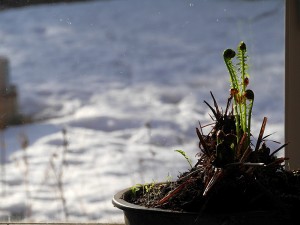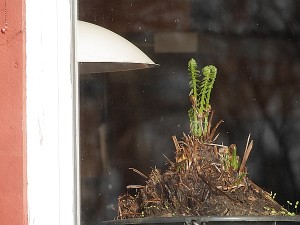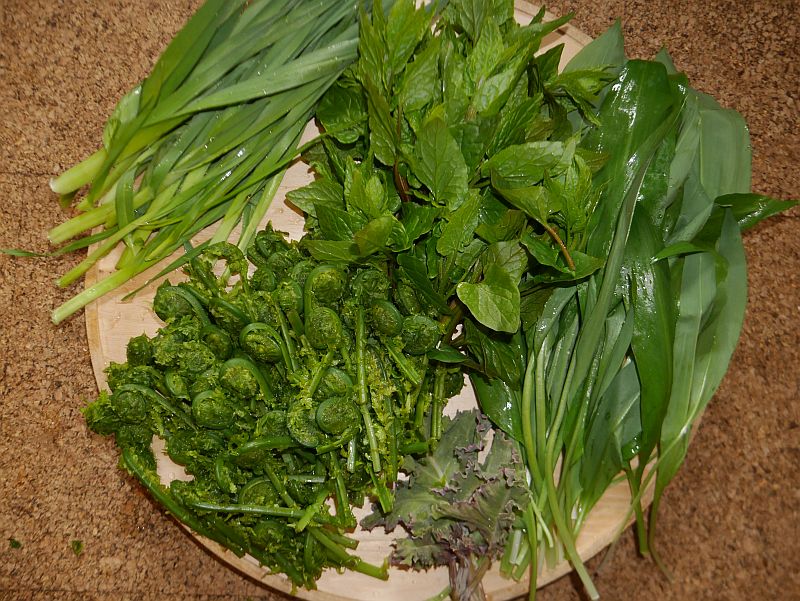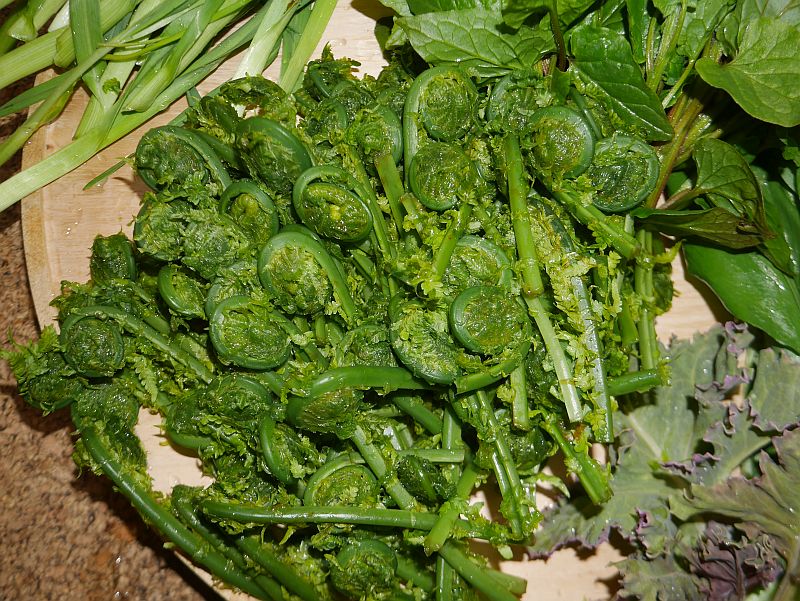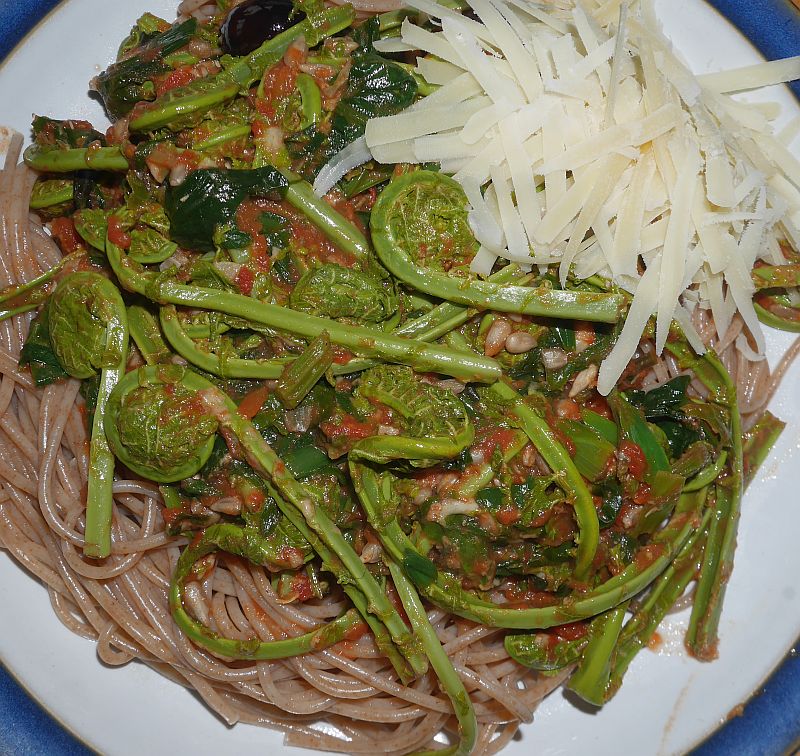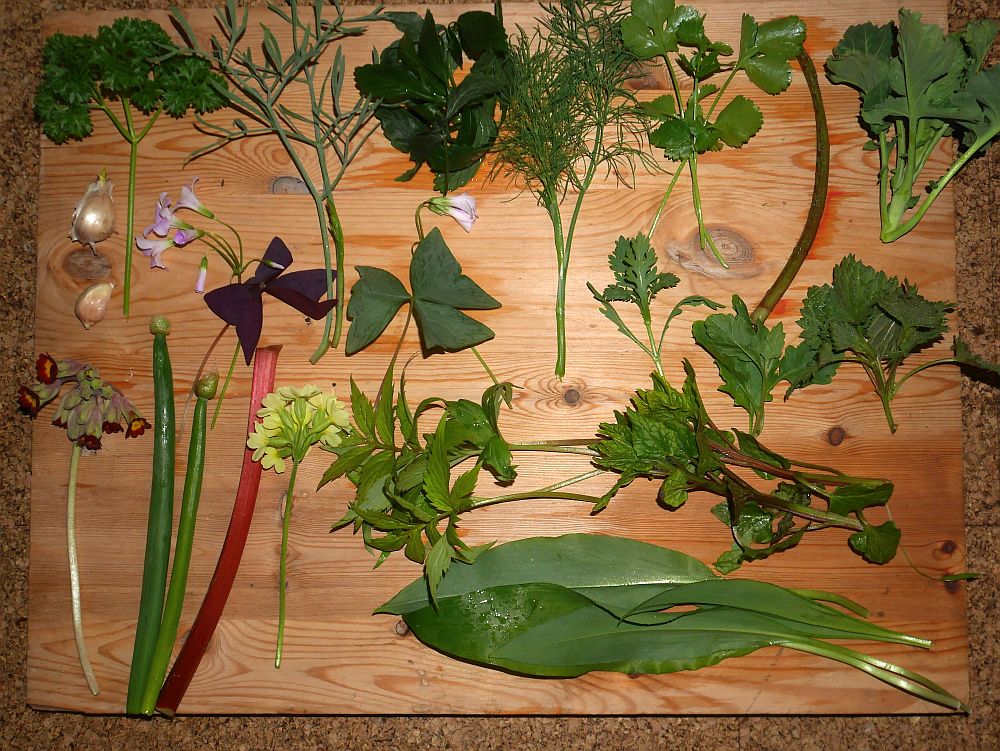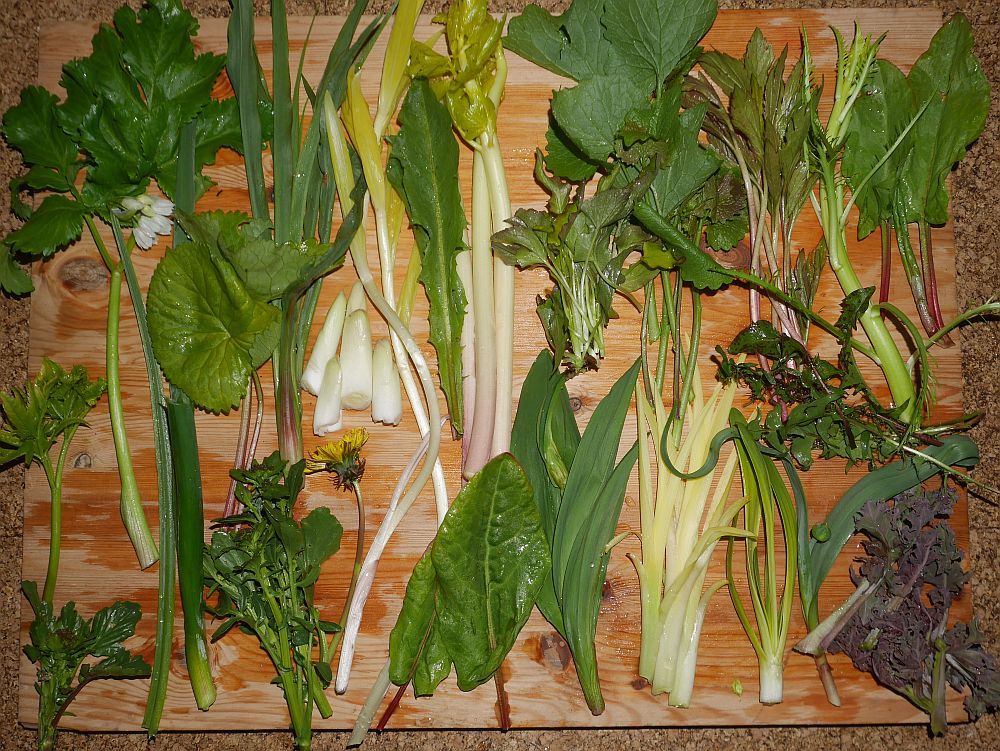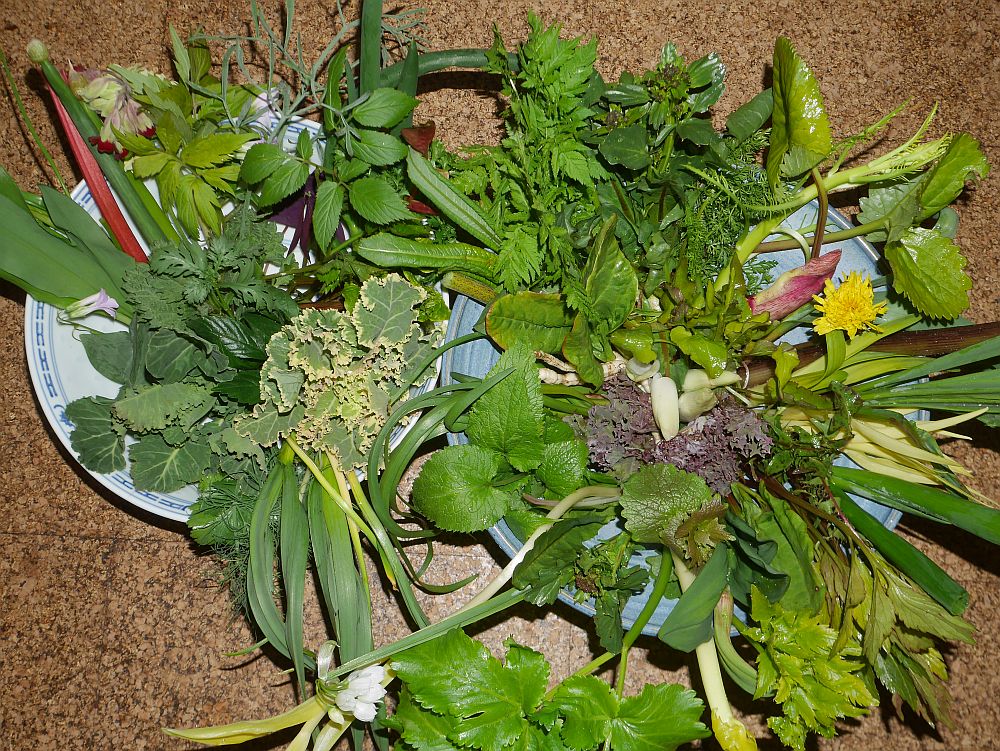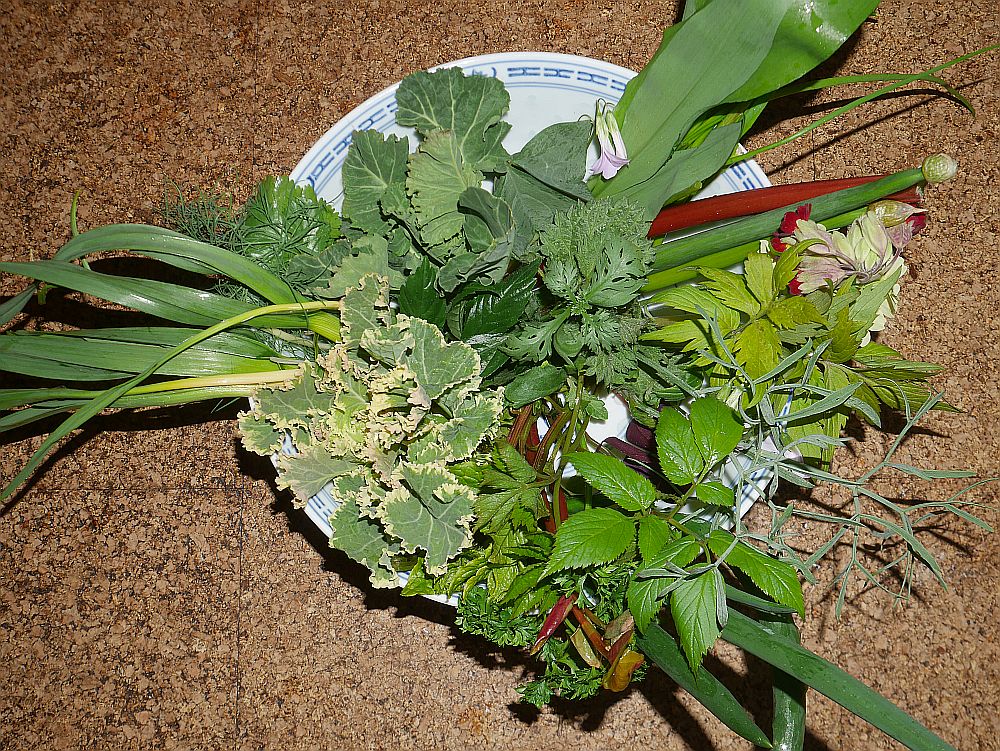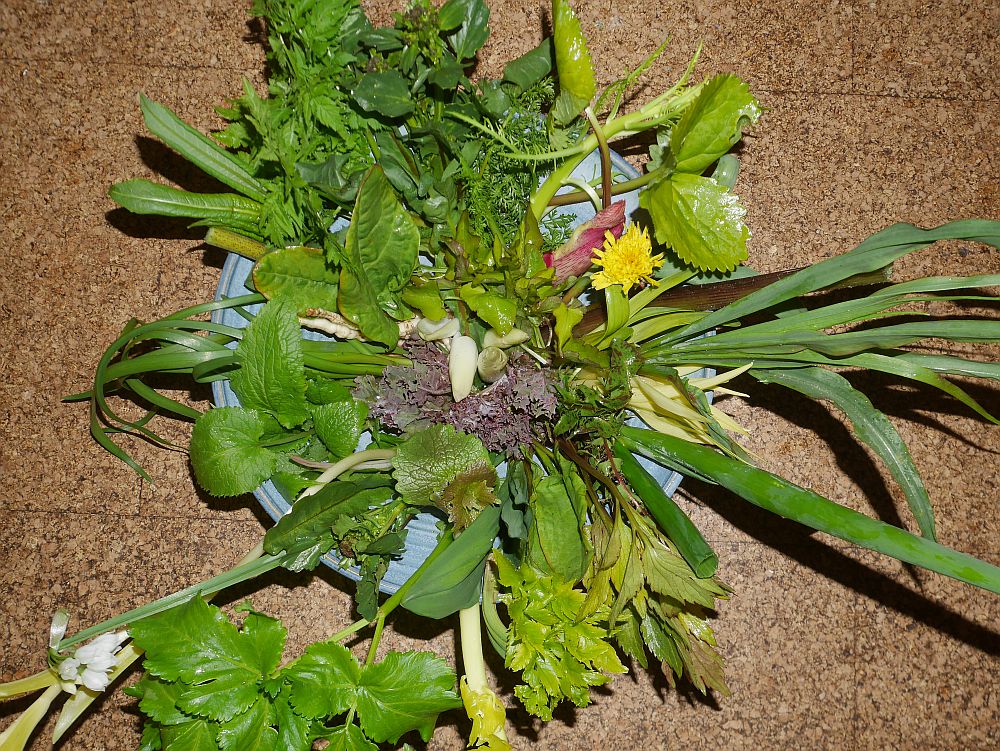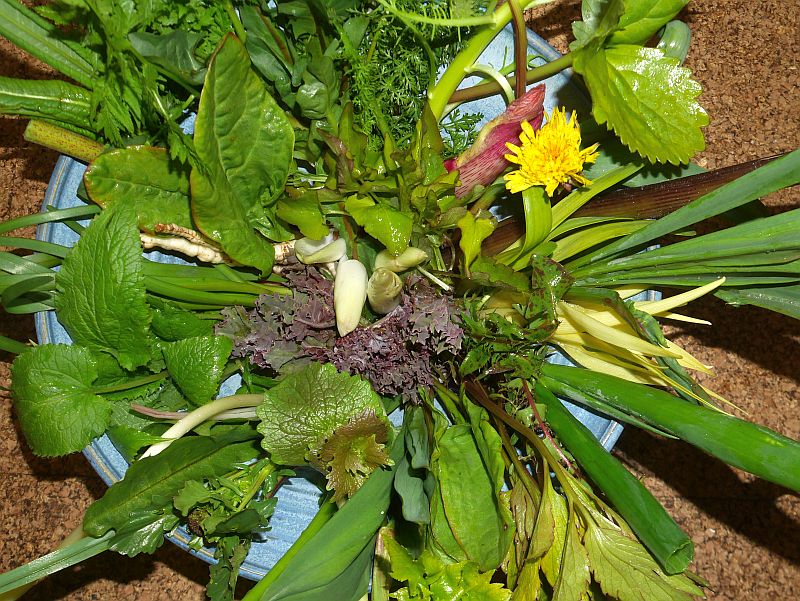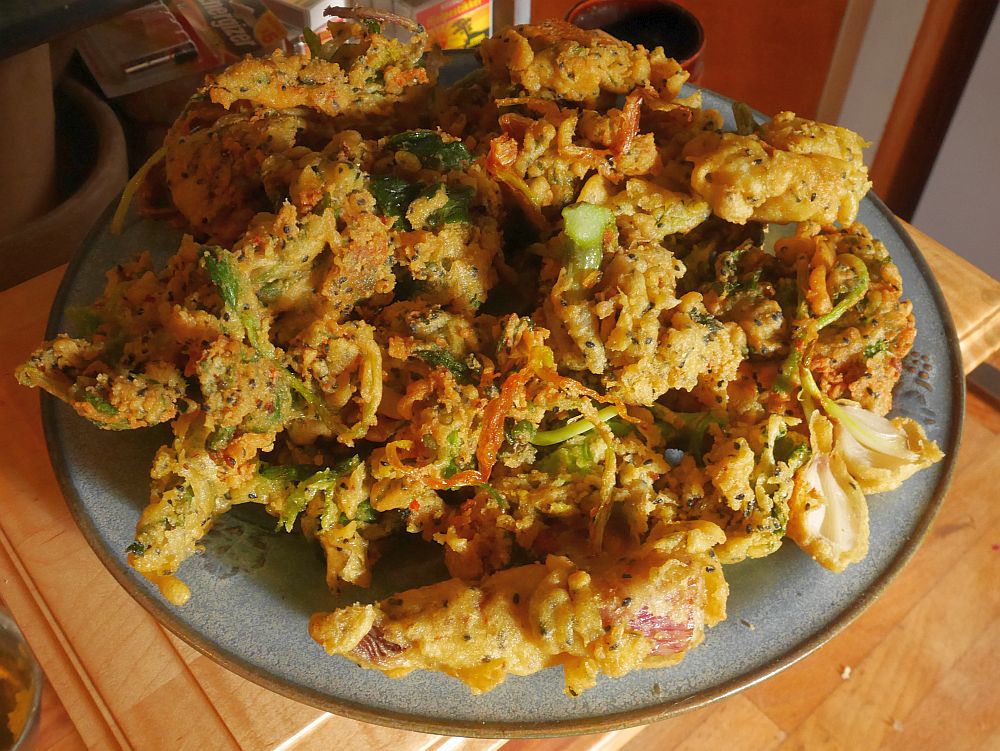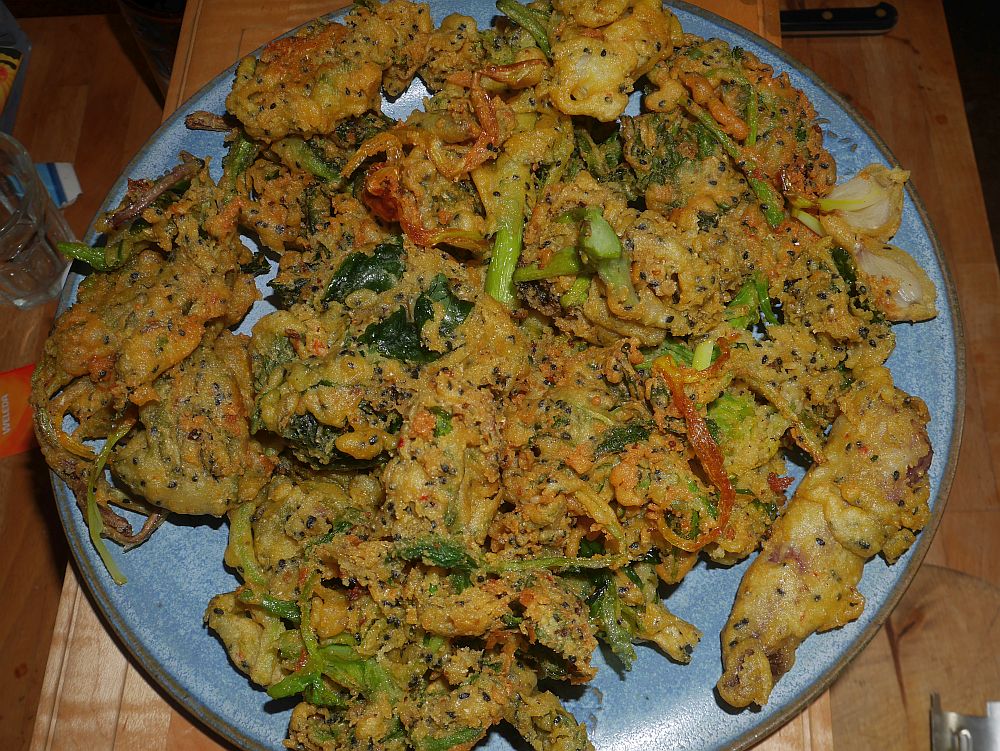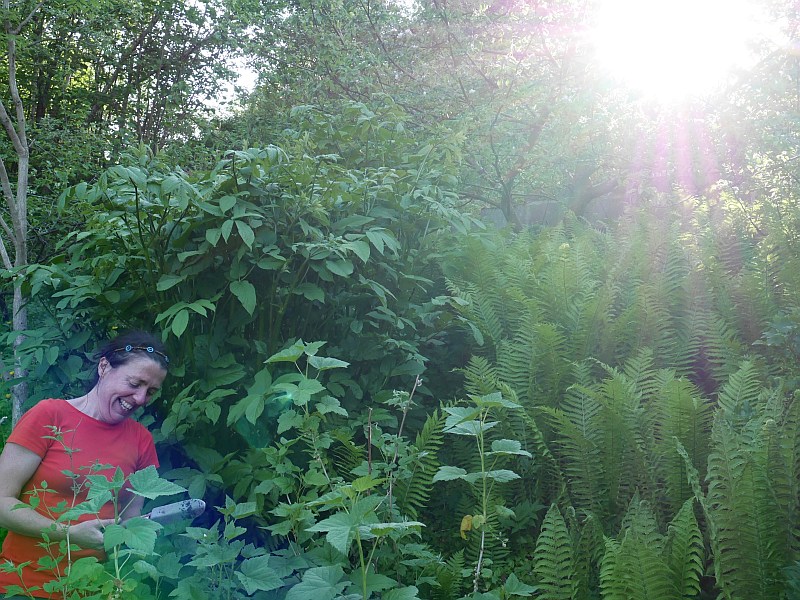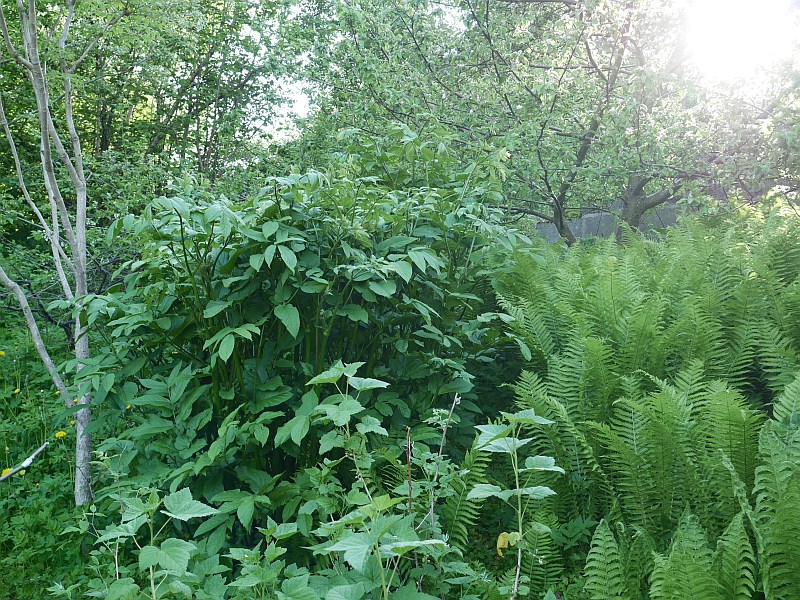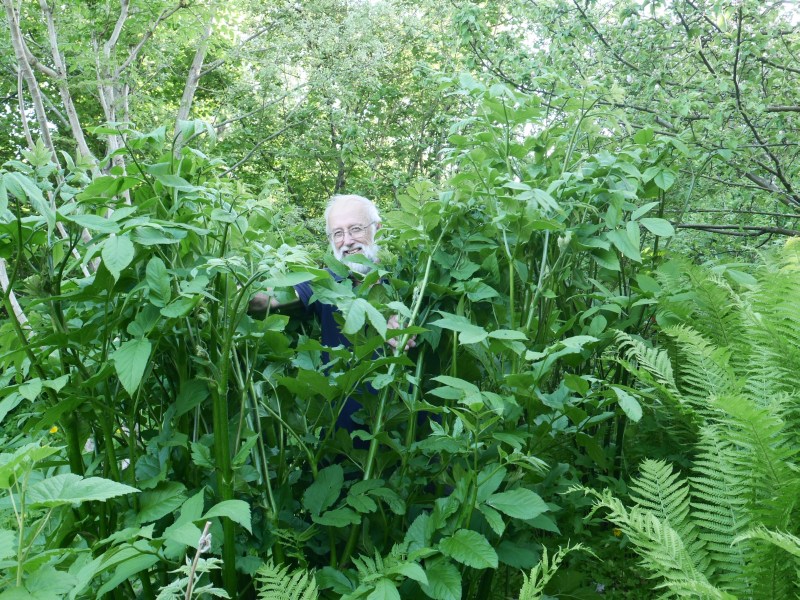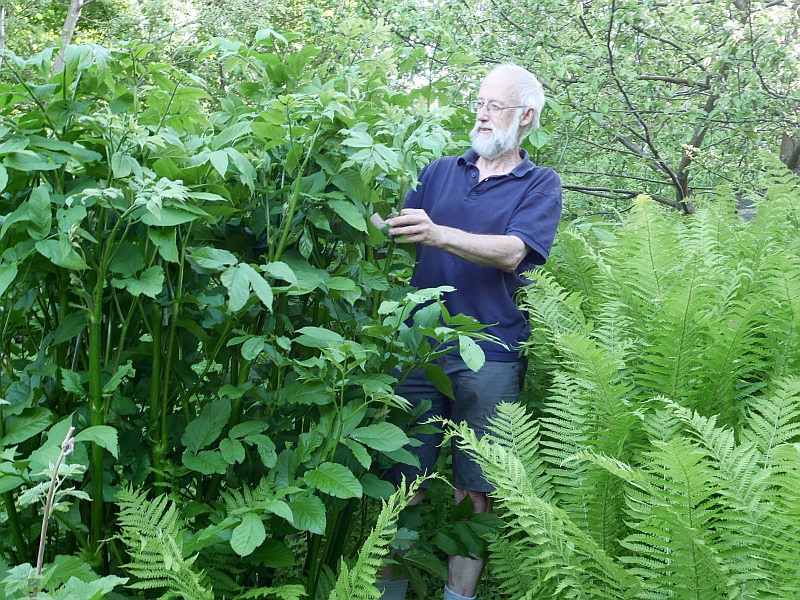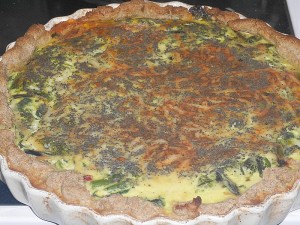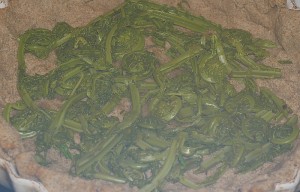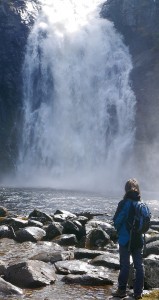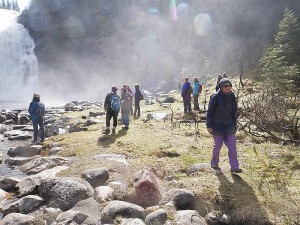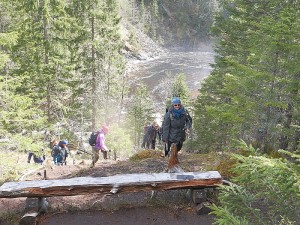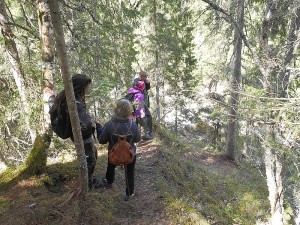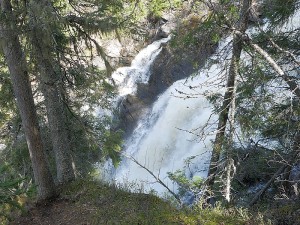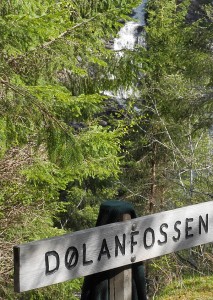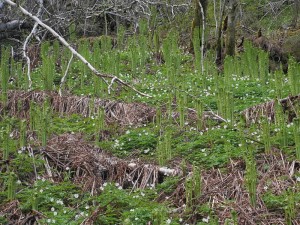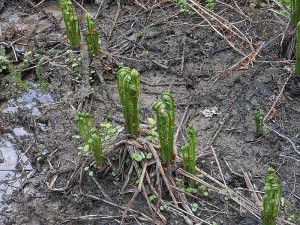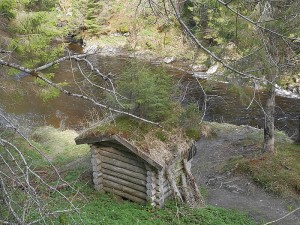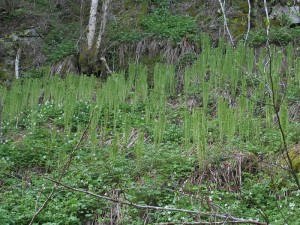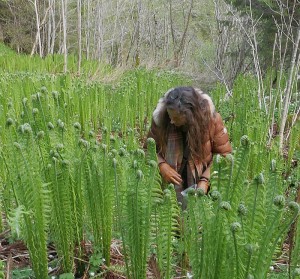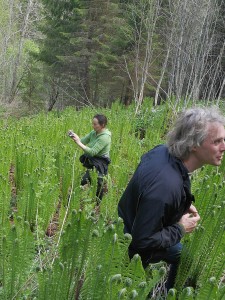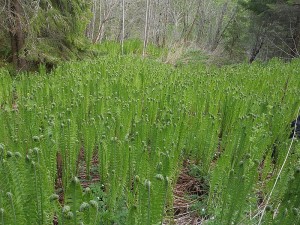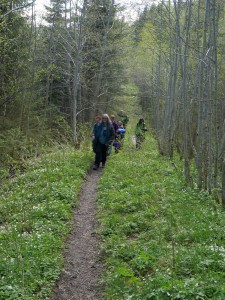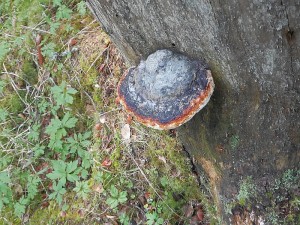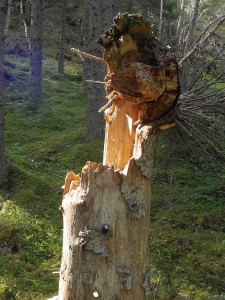I thought I’d take you for a tour of the lower parts of the garden including the forest garden. No commentary, let’s just listen to the birds and observe. In the first video, I unexpectedly stumble on a willow warbler (løvsanger), my first in the garden this year, foraging on the ground in the cold weather….you can otherwise hear singing redwing (rødvingetrost), great tit (kjøttmeis), fieldfare (gråtrost), meadow pipit (heipiplerke), house sparrow (gråspurv) and blue tit (blåmeis) in one of the two videos.
Category Archives: Ferns
Green Ostrich Pasta
I noticed yesterday that the ostrich ferns (strutseving) in the forest garden had put on a spurt despite the cold weather and were almost past the harvesting stage. This is the main disadvantage of this great vegetable. The harvesting window is very narrow. I quickly harvested some, taking care not to take more than 1/3 of the shoots. Together with Hablitzia tamnoides (Caucasian spinach), a bit of sea kale (strandkål), ramsons (ramsløk) and sand leeks (bendelløk) this made a delicious green pasta sauce.
See the video before I picked below!
A 65 Veggie Pakora at 65
To celebrate my 65th we made indian pakora with 65 (or so) different perennial vegetables. Going for a new title, this time EPM (Extreme Pakora Man)! Any better? The whole list is under the pictures!
Just wish I’d had broad / fava bean (bondebønner) flour available for the pakoras rather than gram flour (chick peas)…next time I hope :)
Begonia heracleifolia var nigricans (leaf petiole)
Cilantro / Bladkoriander
Dill
Oxalis triangularis (two varieties)
Gynostemma pentaphyllum (sweet tea vine)
Crithmum maritimum (rock samphire / sanktpeterskjerm)
Parsley / persille
Garlic / Hvitløk “Valdres”
Garlic / Hvitløk “Lochiel”
Garlic / Hvitløk (sprouts)
Chenopodium ambrosioides (epazote / sitronmelde)
Chrysanthemum coronarium “Chopsuey Greens”
Perennial kale / flerærige kål “Heligoland”
Perennial kale / flerærige kål “Daubenton Variegated”
Urtica dioica (nettle / nesle)
Hablitzia tamnoides (Caucasian spinach / stjernemelde)
Allium ursinum (ramsons / ramsløk)
Hydrophyllum virginianum (Virginia waterleaf, Indian salad)
Primula elatior (oxlip / hagenøkleblom)
Primula “Sunset shades”
Rhubarb / rabarbra “Victoria”
Rhubarb / rabarbra “Træna”
Allium fistulosum (Welsh onion / pipeløk)
Allium cernuum (Chicago onion, nodding onion / prærieløk)
Myrrhis odorata (sweet cicely / Spansk kjørvel)
Sium sisarum (skirret / sukkerrot)
Heracleum sphondylium (common hogweed / kystbjørnekjeks)
Allium scorodoprasum (sand leek / bendelløk, skogløk)
Taraxacum officinale (dandelion / løvetann) (leaves, roots and flowers)
Matteuccia struthiopteris (ostrich fern / strutseving)
Houttuynia cordata “Chinese Market”
Allium carolinianum
Allium schoenoprasum (chives / gressløk)
Rheum palmatum var tanguticum (Turkey rhubarb/ prydrabarbra)
Bistorta officinalis (bistort / ormerot)
Allium x proliferum (walking onion / luftløk) “Amish Topset”
Campanula latifolia (giant bellflower / storklokke)
Aegopodium podograria (ground elder / skvallerkål)
Carum carvi (caraway / karve) (leaves)
Aralia cordata (udo) (short blanched shoot)
Crambe maritima (sea kale / strandkål)
Allium douglasii (Douglas’ onion / Douglas-løk)
Allium nutans (Siberian nodding onion / sibirsk nikkeløk)
Hemerocallis spp. (day lily / daglilje)
Allium victorialis (victory onion / seiersløk) “Lofoten”
Rumex acetosa (sorrel / engsyre)
Levisticum officinale (lovage / løpstikke) (blanched)
Smilacina racemosa ( false spikenard / toppkonvall) “Emily Moody” (blanched)
Hosta “Frances Williams”
Tragopogon pratensis (Jack-go-to-bed-by-noon / geitskjegg)
Barbarea vulgaris ssp arcuata (winter yellowcress / vinterkarse)
Barbarea vulgaris ssp vulgaris (winter yellowcress / vinterkarse)
Allium paradoxum var normale (few-flowered leek)
Angelica archangelica ssp archangelica v. Majorum (Angelica / kvann) “Vossakvann”
Dystaenia takesimana (Ulleung giant celery)
Alliaria petiolata (garlic mustard / løkurt)
Rudbeckia lacinata (Cherokee greens)
Armoracia rusticana (horseradish / pepperrot) (blanched greens)
Rumex patientia (patience dock / hagesyre)
Allium pskemense
Taraxacum sublaciniosum “Delikatess” (dandelion / løvetann) “Moss-leaved dandelion”
Taraxacum albidum
Phyteuma nigra (black rampion / svartvadderot) (greens)
(Golpar was in the pakora batter along with chili, ajwain and black onion seed, Nigella)
In the gardens at the Gothenburg Botanics in January
I also walked around the outside gardens during my visit to the Gothenburg Botanical Gardens on Saturday 25th January 2020. In the mild weather, there were many people out walking and running in the garden. Here’s an album of pictures of edibles and other interesting plants and a video of the large Actinidia arguta in the Asiatic woodland garden.
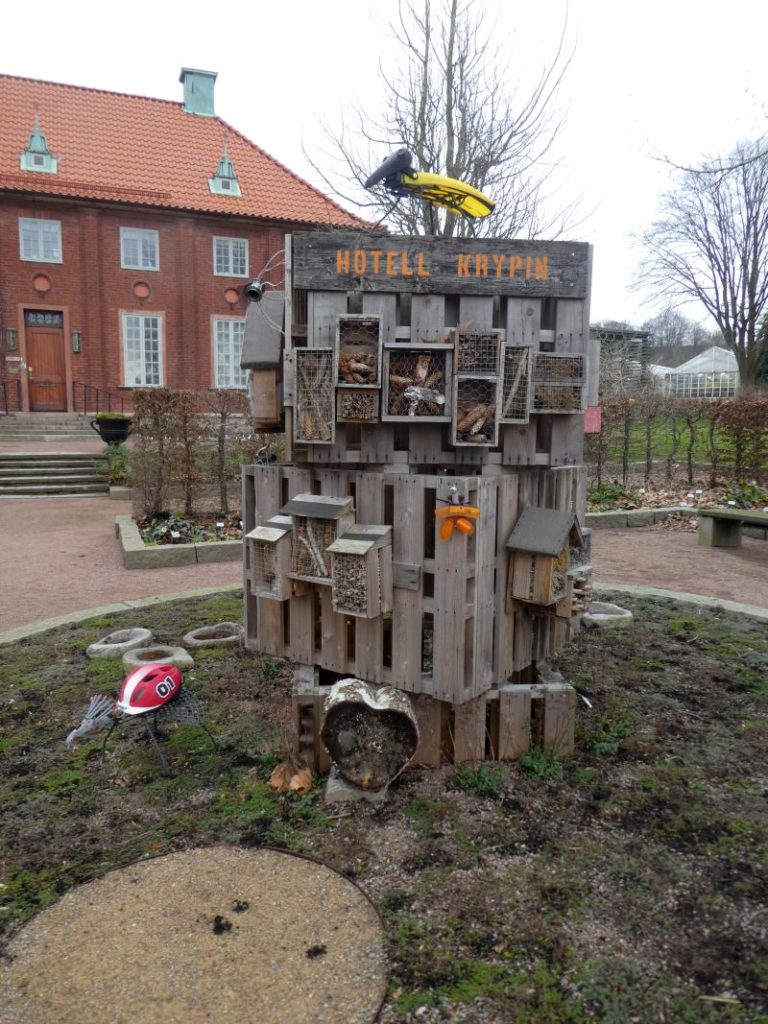
Hotell Krypinn: a great insect hotel 
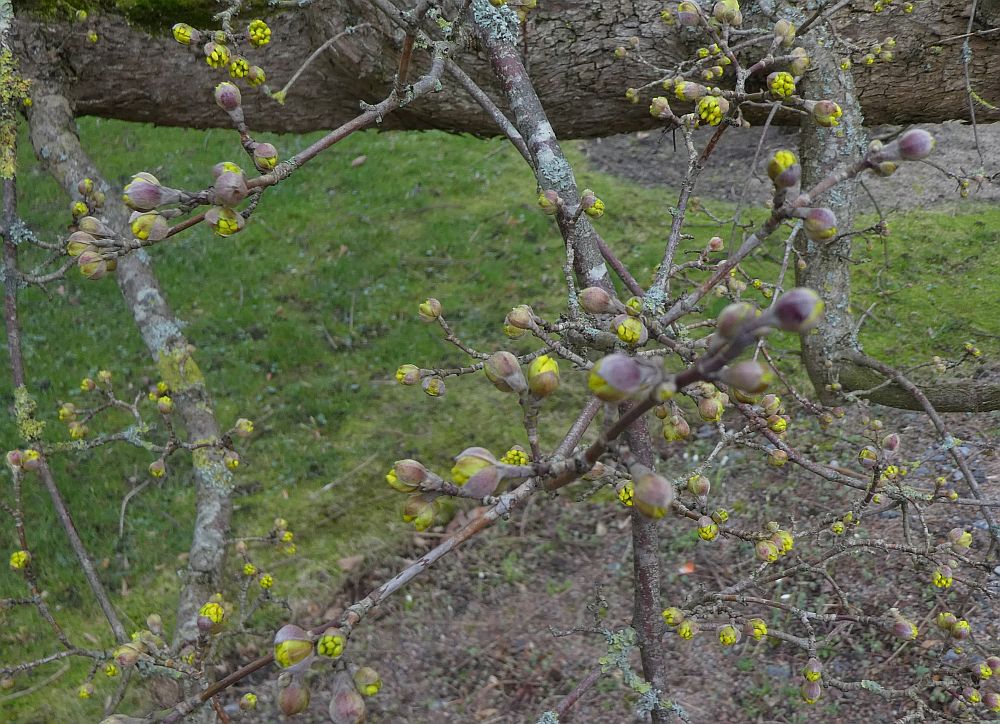
Cornus mas flower buds swelling 
Hemerocallis shoots 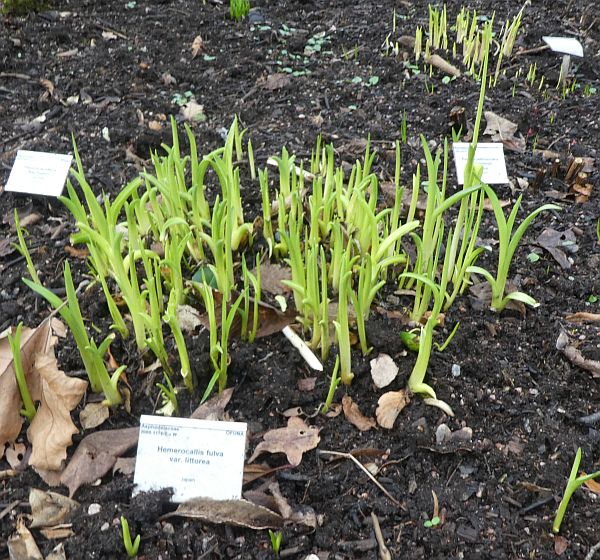
Hemerocallis fulva var littorea 
Ficaria verna (Lesser celandine / vårkål) 
Yucca filamentosa “Color Guard” is a great edimental! (Edible flowers, shoots and fruits) 
Magnolia stellata “Centennial” (the buds may be edible like other Magnolias) 

Flowering Hamamelis (witch hazel) 
Fertile fronds of ostrich fern (Matteuccia struthiopteris) 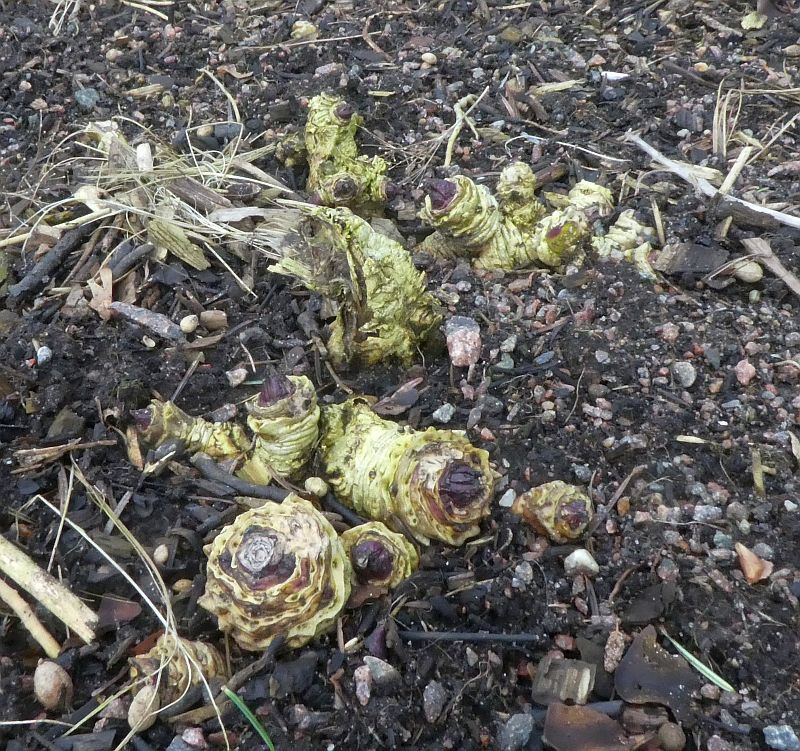
Crambe cordifolia buds 
Eleutherococcus setchuenensis: A family / genus with many edible plants, but no ethnobotanical information on this one 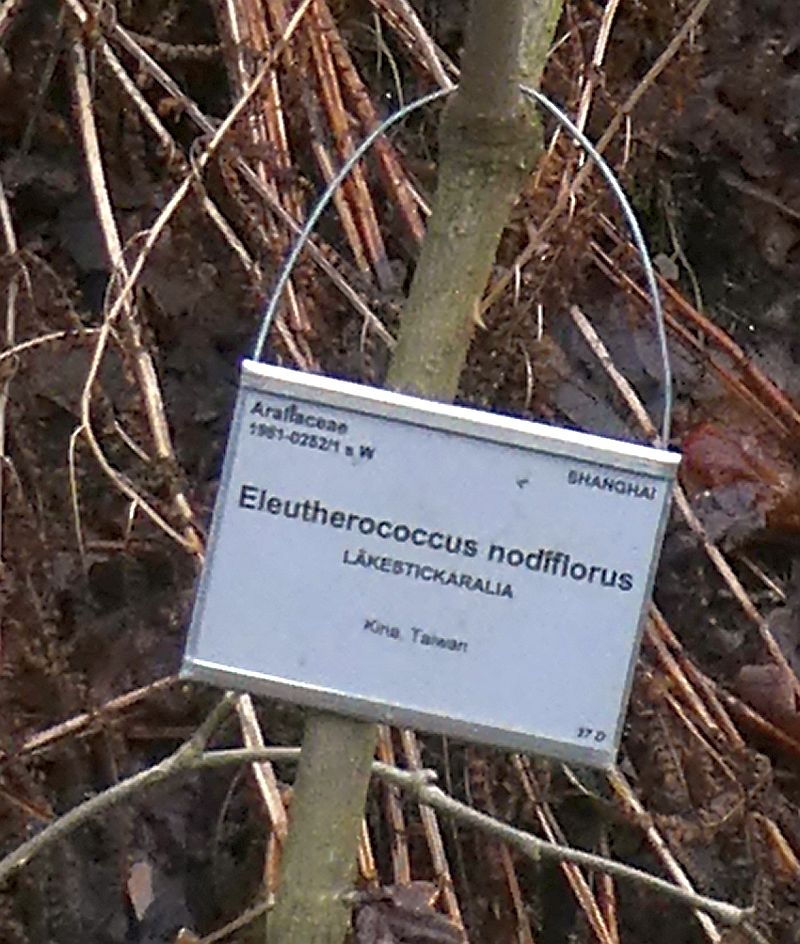
Eleutherococcus nodiflorus: A family / genus with many edible plants, the root is recorded stewed with chicken in China 
Serratula coronata var insularis (the young shoots of this species is recorded eaten in China, but the bitterness is first boiled / soaked away) 
Claytonia parviflora from North America (I haven’t tried this species) 
Smilax rotundifolia (edible shoots) 
Cardamine californica (all parts are edible) 
January flowering Rhododendron dauricum 
Zanthoxylum piperitum (Japanese pepper, sansho) 
Acanthopanax koreanum: A family / genus with many edible plants, but no ethnobotanical information on this one 
Lonicera caerulea var kamtschatica already in leaf 
Polypodium vulgare (sisselrot, sweet fern) 
The world famous Gothenburg Rock Garden 
Garden art on a dead oak tree which is also beneficial for insects by UK artist Stuart Ian Frost 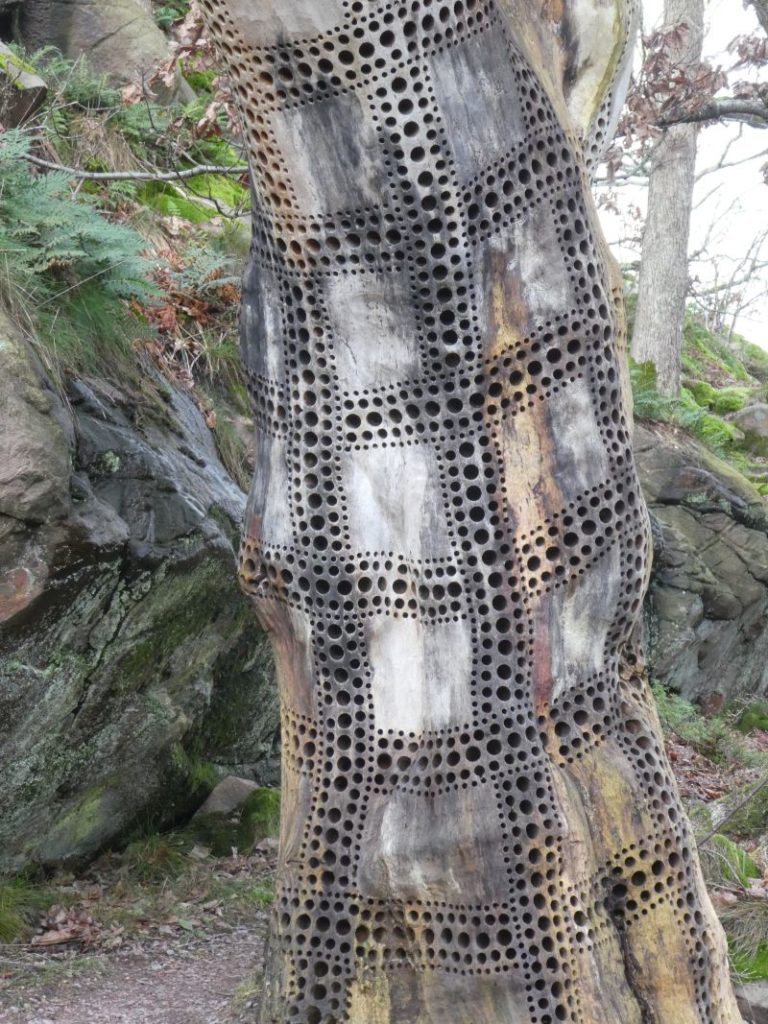
Garden art on a dead oak tree which is also beneficial for insects by UK artist Stuart Ian Frost 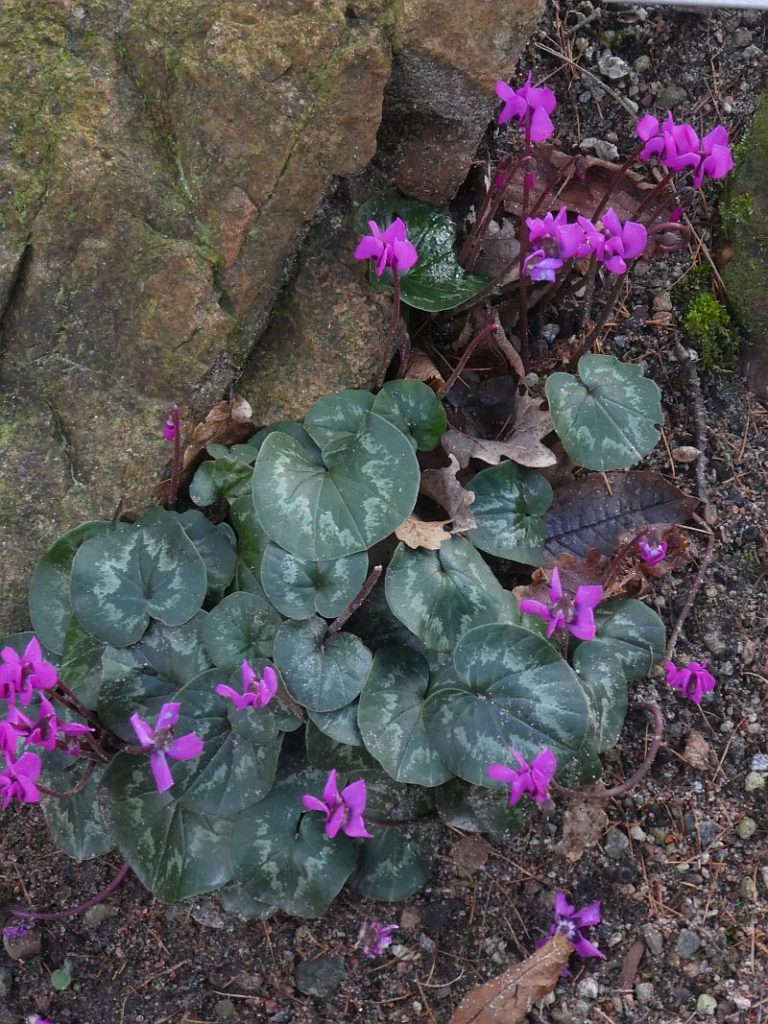
Cyclamen (leaves of some species are eaten) 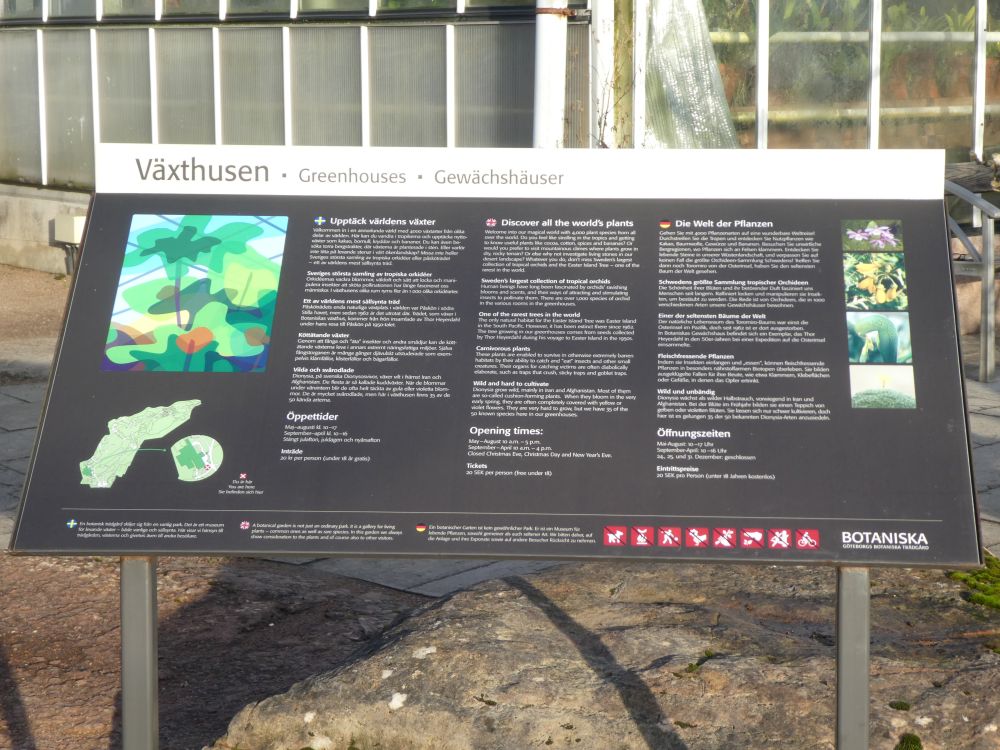
I also visited the greenhouses for the first time, but that will have to be a separate post
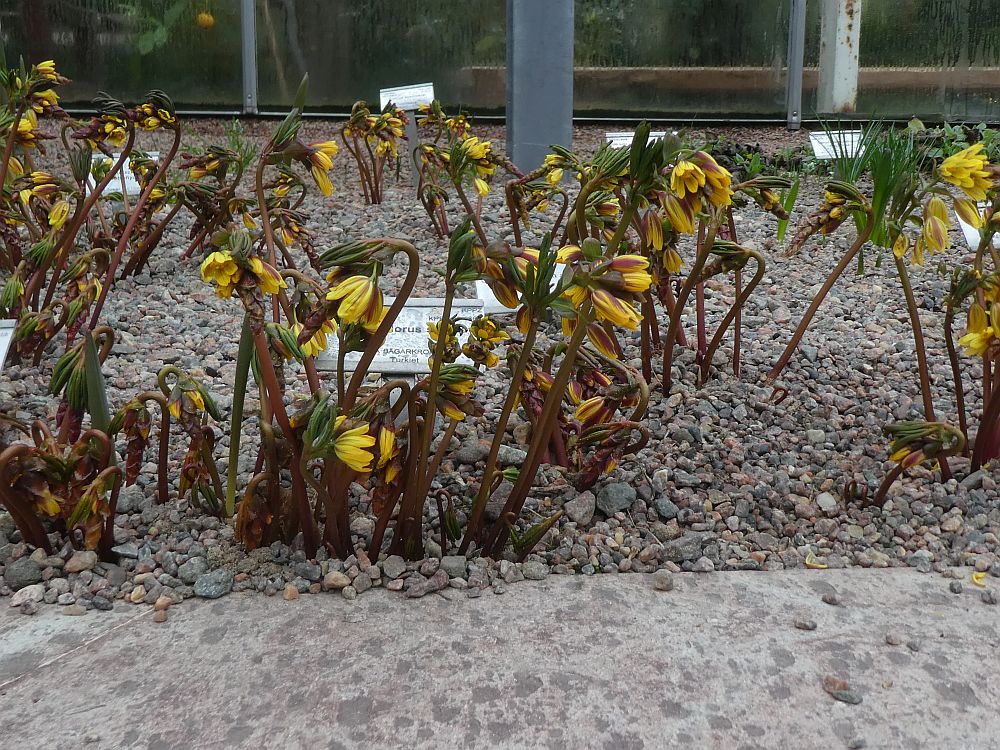
Gymnospermium albertii 
Gymnospermium albertii 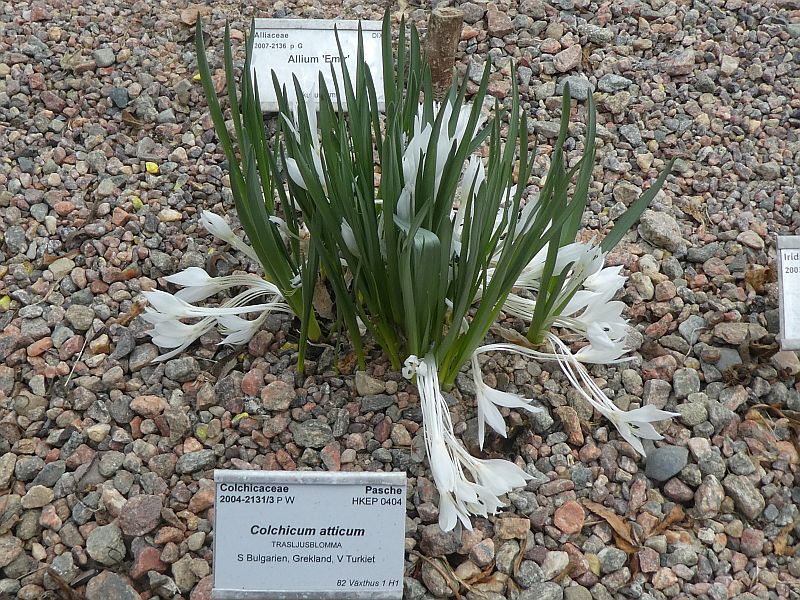
Colchicum atticum 
Colchicum doerfleri 
Colchicum triphyllum 
Iris reticulata 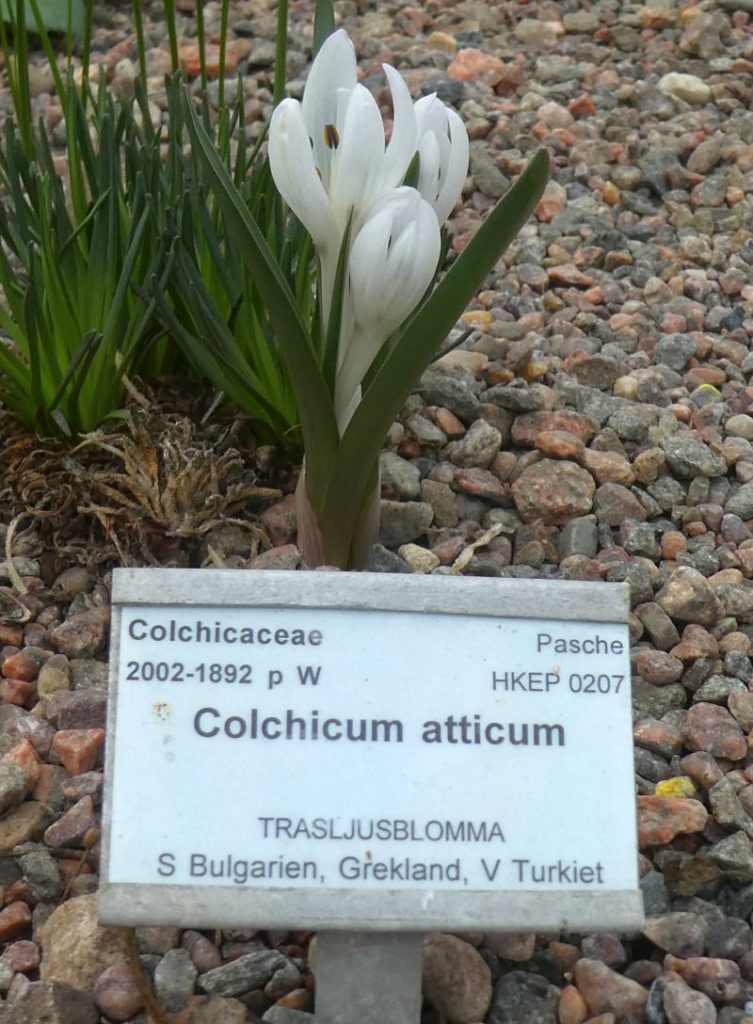
Colchcum atticum 
Iris danfordiae 
Crocus siehanus 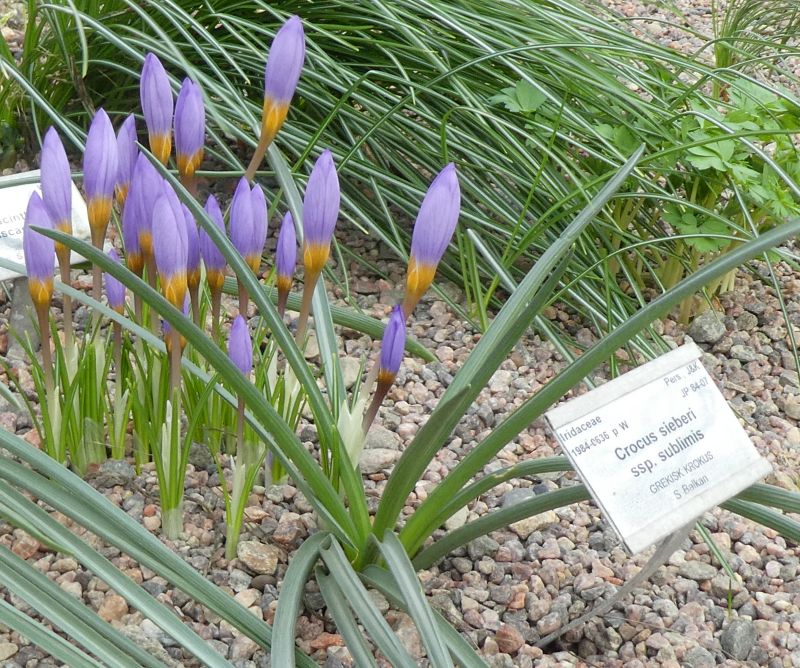
Crocus sieberi 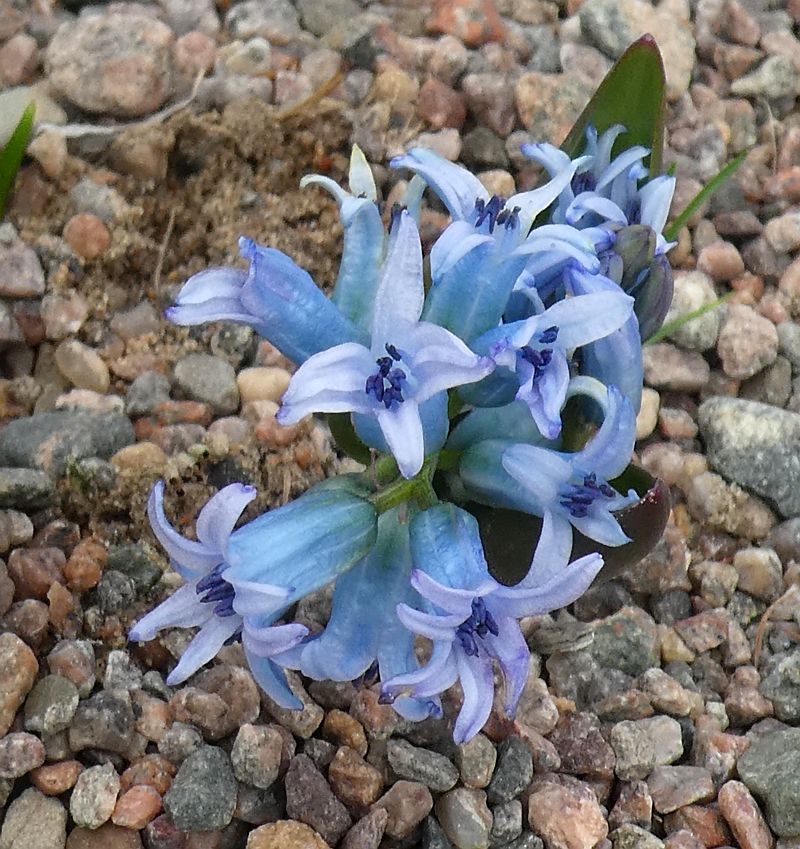
Hyacibnthus transcaspicus 
Corydalis ledebouriana 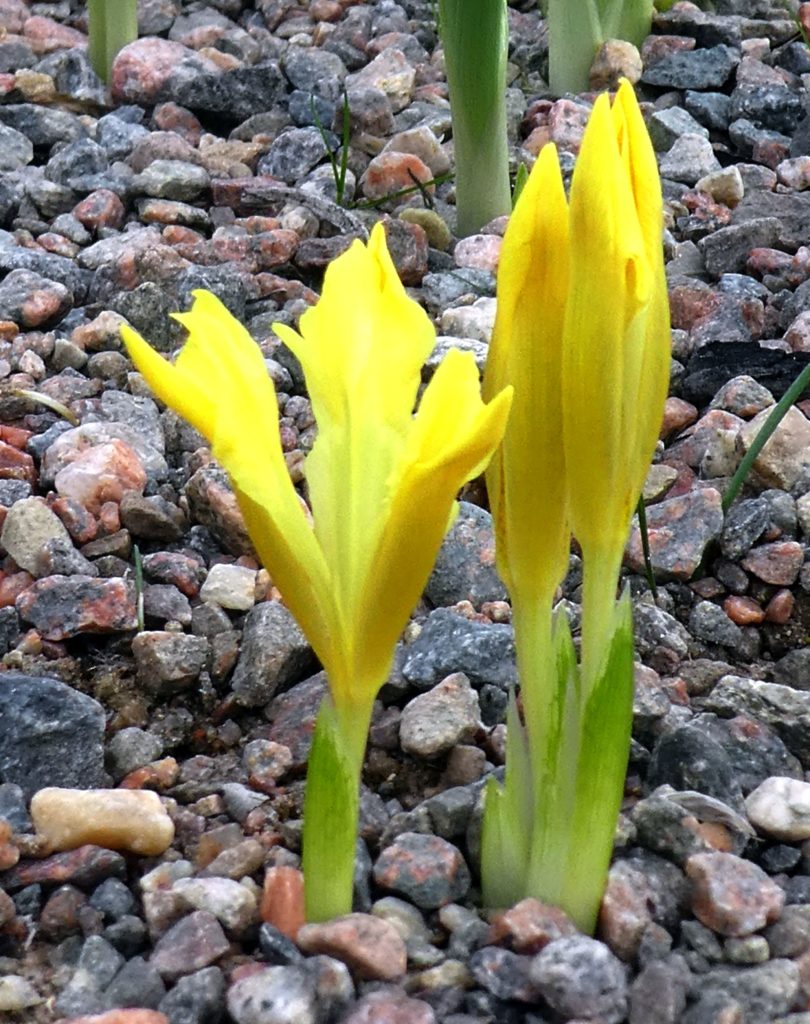
Iris reticulata “Sunshine”C 
Colchicum mirzoevae
Dried ostrich ferns
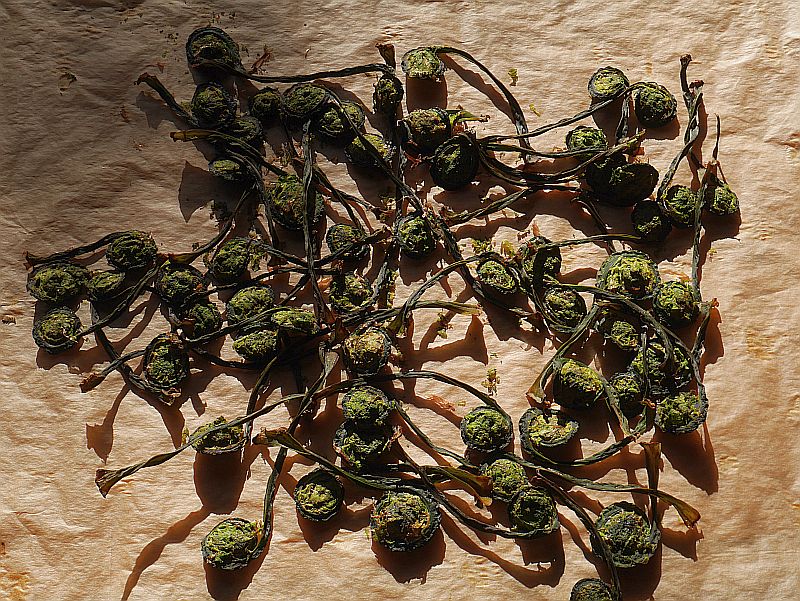
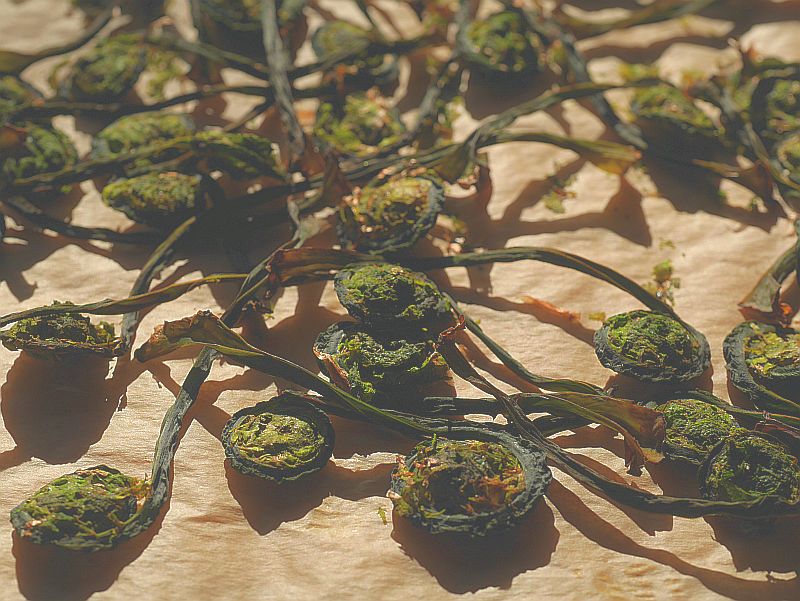
30 point ostrich!
These much shorter fronds which carry the spores are one of the most important distinguishing features of ostrich fern (the taller fronds don’t have spores).
16 days later
The first picture was taken by Christian Odberger during my permaveggies course and just two weeks later the plant is taller than me! The view is or less the same and the apple tree at the back is now in full bloom! The fern is ostrich fern.

Ostrich Fern pie
Permaveggies Course Day 3: Ostrich fern tour along the Homla

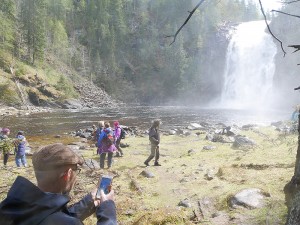
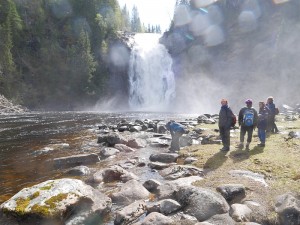
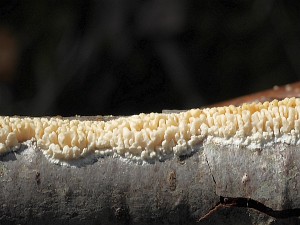
Basidioradulum radula (Tannsopp), earlier classified with the Hedgehog fungi!
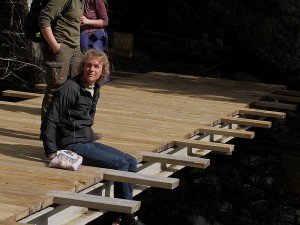
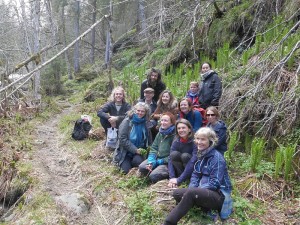
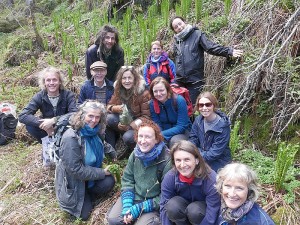
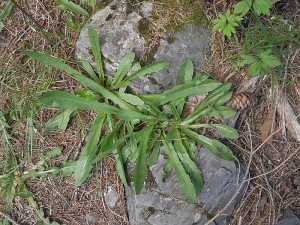
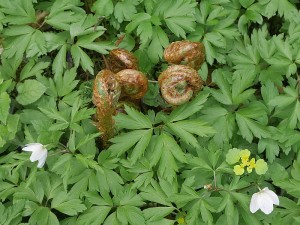
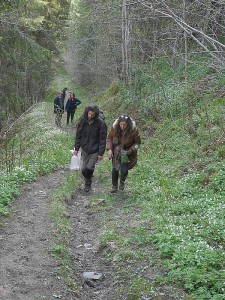
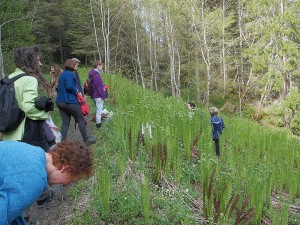
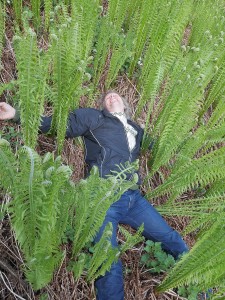
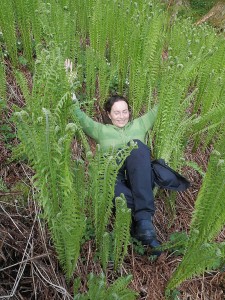
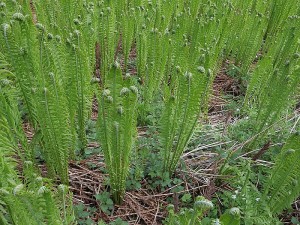
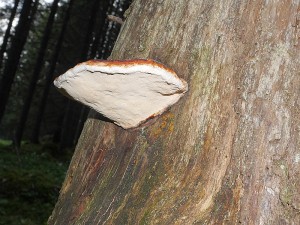
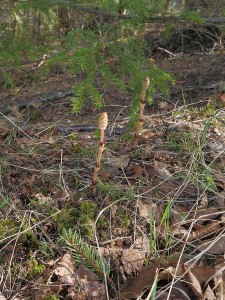
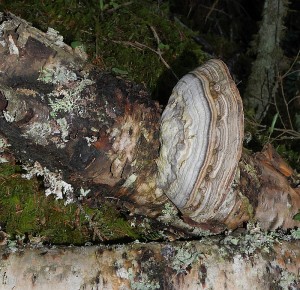
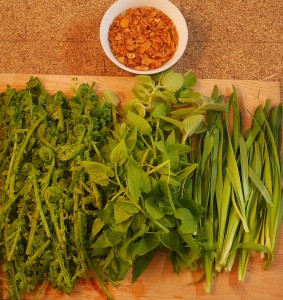
Forced ostrich wings…
